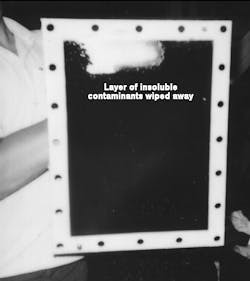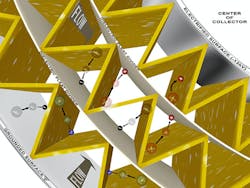Technicians and engineers at Saturn Corp. use a particle-counting program to measure the size and concentration of particles in hydraulic fluid in their injection molding machines. They record results according to ISO (International Standards Organization) cleanliness standards, and the majority of their reports indicate that the fluid seems suitably clean for continued use.
Hydraulic fluid in Saturn’s injection molding machines is filtered to 1-μm absolute in their Polymers (body components) Module and to 3-μm absolute in their Vehicle Interiors Systems (VIS) Module. The total hydraulic reservoir and line capacity of injection molding machines in Saturn’s Polymers Module is approximately 24,100 gal and approximately 10,500 gal in the VIS Module.
Both facilities maintain very clean systems that normally exceed an ISO cleanliness of 14/12. Reports continued to indicate that fluid was clean and still serviceable — even after the fluid had been used approximately 2½ to 3 years — due to the low ISO code ratings that resulted from testing. However, complaints began to occur about fluid discoloration, odor, element plugging, more-frequent element changes, lacquer build-up, and sticking valves.
Getting to the source
We sent a used fluid sample, plugged filter element, and magnet from an injection molding machine in Saturn’s VIS Module to Mobil Oil Corp.’s Technical Services Laboratory in Princeton, N.J. The lab ran a standard deposit analysis in an attempt to determine the cause of the fluid contamination and degradation as well as component wear and deterioration.
The deposits were broken down into four general components:
• an oil fraction, which is soluble in hydrocarbon solvent,
• a deteriorated organic fraction, which is soluble in a chlorinated solvent,
• salts, which are soluble in water, and
• insoluble deposits.
The lab advised us that the insoluble sediment consisted of soaps, inorganic sulfates, and carbonates resulting from fluid degradation. These minute deposits of oil oxidation and nitration compounds caused the lacquer deposits, valve sticking, and element plugging. These insoluble sediments consisted of particles less than 5 μm in size and could not be detected in fluid analysis by particle counting.
More recently, the lab has conducted these tests on fluid samples:
• viscosity — to determine if the fluid is within the correct ISO viscosity grade?
• metals — to determine if additives are present in high enough concentrations
• infrared — to determine if the fluid is contaminated with another oil, and
• ultra centrifuge (UC) sediment — to measure the fluid’s cleanliness. This test spins out insoluble contaminants that have destabilized as a result of oil degradation.
Technicians from Saturn’s BC and VIS Divisions sent five hydraulic fluid samples to be tested. The Polymers Module submitted samples from three machines that had been experiencing fluid discoloration, an oxidized odor from the fluid, and element plugging. The VIS Module submitted samples from two machines, one of which had not exhibited any problems.
Test results from this machine’s sample came back with a satisfactory rating. However, samples from the four other machines were rated as not suitable for continued service due to excessive UC sediment (insoluble contaminants).
Examining the evidence
The photo shows areas of the hydraulic reservoir of an injection molding machine from the VIS Module The photos were taken when the hydraulic fluid in this machine was changed on June 19,1993. The fluid was filtered with a 3-μm absolute filter and had been in service for about 2½ years at a typical operating temperature of approximately 110° F.
The discolored fluid in this system had an oxidized odor, and the element was plugging. Saturn technicians sampled fluid from this system four days earlier and added 75 gal (12.5% by volume) of solvent to the system after it had been in operation for 9,765 hr. Samples were sent to a lab in Atlanta and to the Mobil Technical Services Lab in Princeton. The machine ran continuously for 97 hours, and the oil/solvent was drained from the system at 9,862 hr while the fluid was still hot.
Test results from the lab in Atlanta revealed that the fluid was very clean — with an ISO code rating of 14/12. Based on the particle count, the fluid was in satisfactory condition and suitable for continued service. However, results from Mobil’s lab showed that the fluid contained insoluble contaminants and had a sediment rating of 8.
The test rates a fluid’s sediment content on a scale of 1 to 8, with 1 being the worst, and 7 and 8 being unsatisfactory. Their action code recommended that the system be drained, flushed, and replenished with fresh fluid.
When we drained the system and inspected the reservoir, we found the walls, floor, manhole cover, suction stub, magnet, and suction strainer coated with a layer of contaminant deposits. This supported the unsatisfactory rating from the Princeton lab.
What causes formation of insoluble contaminants?
The combined forces of heat and moisture may cause hydrolytic degradation of a hydraulic fluid. Hydrolytically unstable oils form acidic and insoluble contaminants, which can cause hydraulic system malfunctions similar to those produced by oxidation and thermal degradation of fluids. In addition, hydrolytic stability is a primary factor in the wet filterability behavior of hydraulic oils. ASTM D-2619 describes a standard test for measuring hydrolytic stability of hydraulic fluids.
In the test, 75 g of fluid and 25 g of water are sealed in a clean bottle with a copper strip for 48 hr at 93° C (200° F). At the end of the test, the oil and water layers are separated and insoluble particles are weighed. Viscosity and acid numbers are also determined based on the Denison HF-0 specification. The weight loss of the copper specimen should be less than 0.209 mg, and the acid number of the water phase should be less than 4.0 mg KOH/g. Hydrolytic stability is an important design characteristic because exposure to water can be expected throughout the life of hydraulic fluids.
ASTM also publishes ASTM D4898 - 90, Standard Test Method for Insoluble Contamination of Hydraulic Fluids by Gravimetric Analysis. This test method indicates and measures the amount of insoluble contamination of hydraulic fluids. Minimizing the levels of insoluble contamination of hydraulic fluids is essential for the satisfactory performance and long life of the equipment. Insoluble contamination can not only plug filters but can damage functional system components resulting in wear and eventual system failure. To learn more and to order the document, visit www.astm.org/Standards/D4898.htm.
Findings and recommendations
We recommended that Saturn not use conventional particle analysis techniques as the sole criterion for determining when to change hydraulic fluid. Particle counting is suitable for measuring particles larger than 5 μm, but is not effective for measuring insolubles that have destabilized as a result of fluid degradation. These insoluble soaps, inorganic sulfates, and carbonates lead to deposit build-up, valve sticking, and filter plugging. Conventional particle count tests are not sensitive enough to pick up the low quantities of contaminants involved.
Insoluble contaminant deposits cannot be removed effectively by adding solvents to the existing oil and flushing the system. Effective cleaning can only be performed manually. We also recommended that Saturn implement specific programs for measuring insolubles in the injection molding machines’ hydraulic fluid.
Finally, we are investigating an electrostatic oil conditioning (EOC) system to remove these insoluble contaminants from the fluid before they can accumulate and cause system problems. The EOC system is a low velocity, off-line process that uses electrodes to collect particles based on a positive or negative charge inherent to them. The result is oil purification and varnish removal.
The EOC system does not charge particles or the oil, but, rather uses a vertically positioned electrode to produce a strong electrostatic field between itself and a ground surface within the system's pleated cellulose collector element. As oil passes upward through this electrostatic filter element and parallel to the electrode and ground surfaces, suspended contaminants as small as sub-micron are forced by the voltage field against the collector media and removed from the oil.
As fluid flows through the oil purification system, it removes contaminants, submicron particles, dust, dirt and products of oil oxidation, including hard and soft particles, tars, and varnishes. These contaminants are trapped in the collector for easy disposal.
Referring to the illustration, particles with a positive charge are drawn toward a negative electrode within the system, while those with an inherent negative charge are drawn toward a grounded plate. A charge-neutral particle that either is already highly polar in nature, or is polarized by the non-uniform voltage field of the collector is drawn toward the area of the greatest field strength (folds of the collector pleats). The collector attracts neutral particles based on their inherent dielectric constant, drawing them to a collector by a gradient force that exists between the electrodes. The process removes contaminants independent of size, so it can effectively remove the insoluble deposits without affecting soluble additives.
J. M. (Mickey) Jackson, lubrication engineer, Diversey Chemical Management Services, Nashville, is assigned to Saturn Corp., Spring Hill, Tenn. Larry Laake, sales and service coordinator, Kleentek, Cincinnati, a manufacturer of electrostatic oil conditioning systems, also contributed to this article. Visit www.kleentek.com for more information, or click here to download a technical paper describing electrostatic oil cleaning.



